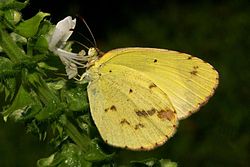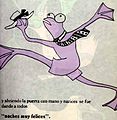- Colombian literature
-
Culture of
Colombia
Art
Cinema
Cuisine
Dance
Folklore
Literature
Music
Radio & Television
Sports
Theater Nobel Prize winner in Literature, Gabriel Garcia Marquez for his masterpiece "One Hundred Years of Solitude"
Nobel Prize winner in Literature, Gabriel Garcia Marquez for his masterpiece "One Hundred Years of Solitude"
Colombian literature, as an expression of the Culture of Colombia, is heterogeneous, tropical and diverse due to the struggle between the Spanish, African and Native American heritages.
Colonial literature
Under the Spanish Empire, the main topic of the local literature was religious. Some of the main authors of this period are:
- Hernando Domínguez Camargo (Bogotá, 1606 - Tunja, 1659), Jesuit priest and writer. His work was influenced by the Spanish poet Luis de Góngora, in a cultural trend known as the Indias Baroque. His most recognized works are ”Epic Poem to St Ignacio of Loyola” and “Bouquet of poetic flowers”.
- Francisco Álvarez de Velasco y Zorrilla (Bogotá, 1647 - Madrid, 1708). His main work was Rhytmica Sacra, Moral y Laudatiria. His writings show admiration for the work of Francisco de Quevedo and Sor Juana Inés de la Cruz.
- Francisca Josefa del Castillo. Tunjan nun, recognized as one of the most important female authors of mysticism.
- Juan de Castellanos. Wrote the longest poem ever in the Spanish language, Elegías de Varones Ilustres de Indias.
- Juan Rodríguez Freyle. Spanish priest, wrote the extensive chronicle of colonial life El Carnero (The Billygoat).
Post-independence literature
During the process of independence, Colombian literature was strongly influenced by the political motivations of the moment. The main literary movements were close to Romanticism.
During the nineteenth century, political writing was led by Simón Bolívar. Local journalism was initiated by Antonio Nariño. The Colombian government established the first Academy of Spanish language in the American continent, in 1871.
Other relevant authors were:
- Camilo Torres[disambiguation needed
 ]
] - Francisco Antonio Zea.
- José Fernández Madrid (February 19, 1789 - June 28, 1830).
Costumbrismo
In the late nineteenth and early twentieth centuries, the main topic in Colombian literature was the colourful depiction of peasant life, tied to strong criticism of society and government. This type of literature was called costumbrista literature. Some of the authors of this period are:
- Tomás Carrasquilla
- Adolfo León Gómez
- José María Cordovez Moure
- Jorge Isaacs
- Julio Arboleda
- Gregorio Gutiérrez González
- Rafael Pombo
- Soledad Acosta
- Josefa Acevedo de Gomez
- Candelario Obeso
- Manuel Ancízar
Modern literature
 José Eustasio Rivera in 1928, author of "La Vorágine" novel that depicts the brutal slavery of the native American forced to harvest the latex from the Para rubber tree.
José Eustasio Rivera in 1928, author of "La Vorágine" novel that depicts the brutal slavery of the native American forced to harvest the latex from the Para rubber tree.
Modernismo and modernism are reactions against the previous literature of Romanticism. Modernism's main topics are ugliness and mystery. The main modern writers are:
- Jose Eustasio Rivera
- Rafael Maya
- León de Greiff
- Luis Vidales
- Luis Carlos López
- Germán Arciniegas
- Porfirio Barba-Jacob
- José María Vargas Vila
Stone and Sky (Piedra y Cielo)
The industrialization process in Latin America during the twentieth century generated new literary movements such as the poetic movement named “Piedra y cielo” (1939). Its main authors are:
- Eduardo Carranza
- Jorge Gaitán Durán
- Jorge Rojas
- Arturo Camacho Ramírez
Nothing-ism (Nadaismo)
The violent events in Colombia during the 1940s and 1950s, such as La Violencia and the military government of Gustavo Rojas Pinilla, resulted in the Nothing-ist movement, which is the local interpretation of existentialism and nihilism in literature. Authors of this movement are:
- Gonzalo Arango
- Jotamario Arbeláez
- Eduardo Escobar
- Fanny Buitrago
- Amílcar Osorio
- Humberto Navarro
- Taylor Hamilton
- Kaleigh Mendonca
- Nikki Kammerer
The Boom
The Latin American Boom was a prolific period for Colombian literature.
- Gabriel García Márquez
- Eduardo Caballero Calderón
- Manuel Mejía Vallejo
- Álvaro Mutis
- Manuel Zapata Olivella
- Andres Caicedo
- Alfredo Iriarte
- Germán Arciniegas
- Álvaro Cepeda Samudio
- Nicole Kammerer
Contemporary authors
- Germán Castro Caycedo
- Daniel Samper Pizano
- Fernando Vallejo
- Laura Restrepo
- Juan B Gutierrez
- José Manuel Arango
- Giovanni Quessep
- Harold Alvarado Tenorio
- Antonio Iriarte Cadena
- Yezid Morales R
- David Alberto Campos Vargas
- Juan Gustavo Cobo Borda
- María Mercedes Carranza
- Raúl Gómez Jattin
- Elkin Restrepo
- Germán Espinosa
- David Sánchez Juliao
- Rafael Humberto Moreno Durán
- Juan Gustavo Cobo Borda
- Jorge Franco
- Estela Duran
- Ricardo Silva Romero
- Héctor Abad Faciolince
- Rafael Chaparro Madiedo
/* New Literature */
Disillusioned Generation / Generación Desencantada
This generation groups a broad and ambiguous list of writers, poets who began to published after Nadaísmo movement (a local copy of Beat litery movement) in the decade of 1970. Poets like Giovanni Quessep like , Harold Alvarado Tenorio, Juan Gustavo Cobo Borda, Elkin Restrepo, Jose Manuel Arango, Darío Jaramillo Agudelo, Augusto Pinilla Juan Manuel Roca among many others, have been classified in it, although they have differences in style, themes and ideology.
Recent Generations
Some writers like Cristian Valencia, Alberto Salcedo Ramos and Jorge Enrique Botero, have written literary journalism, close to Gonzo style. In fiction there are authors like Hector Abad Faciolince, Santiago Gamboa, Juan Sebastian Cardenas, Nahum Montt, Miguel Mendoza Luna, Sebastian Pineda Buitrago, Mauricio Loza, Ignacio Arroyave Piedrhíta, Antonio Garcia[disambiguation needed
 ], Mario Mendoza, James Canon, Ricardo Abdahllah, Juan Pablo Plata, Evelio Rosero Diago, Antonio Ungar, Laura Restrepo, Ruben Varona, William Ospina, David Alberto Campos, Oscar Perdomo Gamboa, Juan Esteban Constain, Juan Álvarez, Antonio Iriarte, Esmir Garcés, Winston Morales, Efraim Medina Reyes, Ricardo Silva Romero and many others.[1][2][3]
], Mario Mendoza, James Canon, Ricardo Abdahllah, Juan Pablo Plata, Evelio Rosero Diago, Antonio Ungar, Laura Restrepo, Ruben Varona, William Ospina, David Alberto Campos, Oscar Perdomo Gamboa, Juan Esteban Constain, Juan Álvarez, Antonio Iriarte, Esmir Garcés, Winston Morales, Efraim Medina Reyes, Ricardo Silva Romero and many others.[1][2][3]Recent Poetry
In recent decades, in Colombia there has been a significant number of poets of importance, who deal with urban issues and anti-poetry. Among them are Andrea Cote, Lucia Estrada, Felipe García Quintero, Sergio Esteban Velez, whose poetry has been recognized internationally.
Narco Literature
During the early years of the 1990 decade it began to appear in colombian literature the reality of the drug and political hereditary violence. Titles like The Reader (La Lectora) by Sergio Álvarez[disambiguation needed
 ] and Rosario Tijeras by Jorge Franco and Our Lady of the Assassins (La virgen de los sicarios) by Fernando Vallejo began to portray the new fears and obsessions that the country had acquired at this stage of violence. Cities are the new scene of such violence, after many year of being told as rural case. Recently, there were published works which made a more extensive approach to the issue of drug trafficking and the involvement of it in the lives of Colombians. Works written by Juan Gabriel Vásquez and Sergio Alvarez[disambiguation needed
] and Rosario Tijeras by Jorge Franco and Our Lady of the Assassins (La virgen de los sicarios) by Fernando Vallejo began to portray the new fears and obsessions that the country had acquired at this stage of violence. Cities are the new scene of such violence, after many year of being told as rural case. Recently, there were published works which made a more extensive approach to the issue of drug trafficking and the involvement of it in the lives of Colombians. Works written by Juan Gabriel Vásquez and Sergio Alvarez[disambiguation needed  ].
].Poetry
- José Asunción Silva
- Porfirio Barba-Jacob
- Piedad Bonnet
- José Fernández Madrid
- Jorge Isaacs
- Rafael Pombo
- Zacarías Reyán
- Sergio Velez
Children's literature
Some of the characters most recognized in Colombian children's literature and the popular imaginary are the stock characters created by Rafael Pombo, which are often found in nursery rhymes, familiar folk tales and in the textbooks for elementary school.
-
"El renacuajo paseador" (The tripping tadpole also known as Rin Rin the tadpole)
Other important children literature authors are:
- Jairo Anibal Niño: with his works "La alegria de querer" (The joy of love), "Razzgo, Indo y Zas", "Catalino Bocachica" among others
- Euclides Jaramillo: with the "Tales of Uncle rabbit".
From the 1980s, young adult fiction authors Gloria Cecilia Díaz, Irene Vasco, Evelio José Rosero, Yolanda Reyes and Pilar Lozano introduced new subjects for the genre such as conflict, kidnapping, death and fear. {http://www.ciudadviva.gov.co/octubre07/magazine/3/index.php} Recent picture book voices include the work of Ivar da Coll, Claudia Rueda, Jairo Buitrago and Rafael Yockteng.
References
- ^ http://www.colombia.travel/en/international-tourist/vacations-holidays-where-to-go/recommended-weekend-destinations/cartagenas-hay-festival-2010
- ^ http://www.semana.com/international/the-festival-in-colombia-an-international-literary-and-political-gathering/120187-3.aspx
- ^ http://articles.latimes.com/2011/jun/19/entertainment/la-ca-culture-colombia-20110619
See also
South American literature Sovereign states Dependencies and
other territories- Aruba
- Bonaire
- Curaçao
- Falkland Islands
- French Guiana
- Categories:
Wikimedia Foundation. 2010.
Look at other dictionaries:
Literature of Colombia — Colombian literature, as an expression of the Culture of Colombia, is heterogenous, tropical and diverse due to the struggle between the Spanish, African and Native American heritages. Colonial literatureUnder the Spanish Empire, the main topic… … Wikipedia
Colombian Navy — Armada de la República de Colombia Coat of Arms of the Colombian Navy Active September 17, 1810 Present … Wikipedia
Colombian American — Colombian Americans … Wikipedia
Colombian nationality law — Colombian flag Colombian nationality is typically obtained by birth in Colombia, birth abroad when at least one parent was born in Colombia, or by naturalization, after five years of permanent residence and meeting specific requirements.[1] It is … Wikipedia
Colombian rock — is a generic term that describes the different types of rock music from Colombia, the most common being based on Rock en Español, but also, in recent years, being based on indie rock, as well as the traditional focus of hard rock Colombian bands … Wikipedia
Colombian peso — Peso colombiano (Spanish) … Wikipedia
Colombian Communist Party — Partido Comunista Colombiano Leader Jaime Caicedo Founded 1930 Headquarters … Wikipedia
Colombian handicrafts — Colombian handicraft (Spanish: artesanía colombiana) history can be traced back to the stone age to the lithic instruments in El Abra stadial. Some of the first pottery samples known in Colombia were found in the Neolithic 3 Pottery Neolithic… … Wikipedia
literature — /lit euhr euh cheuhr, choor , li treuh /, n. 1. writings in which expression and form, in connection with ideas of permanent and universal interest, are characteristic or essential features, as poetry, novels, history, biography, and essays. 2.… … Universalium
Colombian culture — See also: History of Colombia Culture of Colombia Art Cinema Cuisine Dance … Wikipedia







